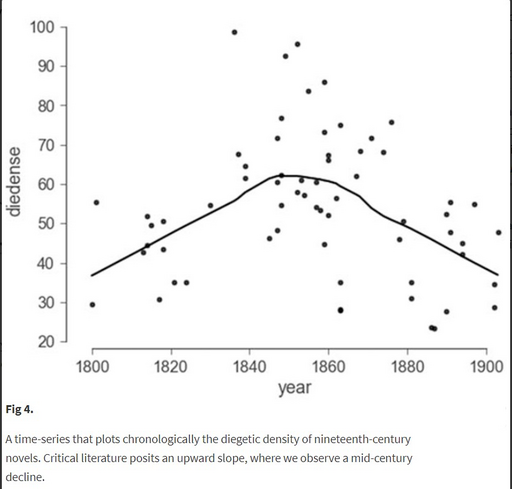Things
Introduction
Representations of objects differ significantly in literature. For example, some works are almost obsessed with using descriptions of the world, and prioritize this over dialogue and reflection. In other works it is the reverse, with very few references to objects.
A computational approach to understanding how things (and animals and people, etc.) appear in a work may be helpful in two ways.
1) The inclusion or exclusion of certain objects may indicate a telling shift in perspective in literature, or even in the works of one author. Virginia Woolf often refers to trees and flowers, but with a remarkable difference in frequency across her novels. Understanding the change in how phenomena are included may be very telling at the scale of a single work, and all the way up to larger corpora (for example, there are many more dogs in English fiction than there were a century ago).
2) It is also possible to study the density of the occurrence of references to objects (see Tenen, 2018), which in turn reveals how writers and literature construct a literary space.
Applications
Elementary
To get an overview of how certain things are present in literature, Google Ngram Viewer makes it possible to plot the appearance of the chosen things over time. As mentioned in the introduction, try for example plotting the appearance of “dog” in literature to see how its popularity increases.
Focusing on a particular text, a simple analytic approach would be counting the number of selected references to objects and comparing their occurrences throughout the text or in comparison with other texts. This approach could also be used to investigate the representation of objects relative to the representation of dialogue and reflection. Use an annotation tool, such as Catma or AntWordProfiler, to start analysing the presence of things in a book.
To visualise the initial observations, explore the different interactive tools of Voyant Tools. For instance, create a Terms Berry with a certain object or investigate its appearance in context with the Context tool.
Advanced
Objects can carry different importance and meaning in literary works, and a computational analysis can shed light on the ‘material’ characteristics of a book’s fictional space. Thinking of space in terms of objects, instead of dimensions, as done by Tenen (2018), allows for exploring the development of material culture. Based on grammatical and semantic categories he introduces an analysis to the material aspect of literary space. For instance, material density, i.e. how many objects there are per location or textual unit, is revealing about the characteristics of a narrative space.
Following Tenen’s methods, calculate the material density of a novel, approximated through used noun phrases. You can retrieve the grammatical categories in Python with Spacy, and filter the word lists according to the supersense labels as mapped in the WordNet lexical database. Additionally, have a look at Dunđer, Pavlovski, and Seljan’s article (2020) about a computational analysis of spatiality in literature, and apply the principles to build concordance plots on the appearance of things, instead of places, in a book. To do this in Python, Stefan Sinclair’s series “Art of Literary Text Analysis” offers a comprehensive guide for pre-processing the text.
Resources
Scripts and sites
- Google Books NGram Viewer, an online search engine that plots the frequencies of any set of search strings as n-grams.
- Voyant tools, a web-based reading and analysis environment for digital texts.
- RealPython’s guide to dependency parsing using SpaCy in Python.
-
A list of WordNet lexicographer file names: based on syntactic category and logical groupings.
-
An extensive series of Jupyter Notebooks for literature analysis in Python.
-
AntWordProfiler, an open-source tool for profiling the vocabulary level and complexity of texts.
- Annotation tutorial for Catma.
Articles
-
Dunđer, I., Pavlovski, M., & Seljan, S. (2020, April). Computational Analysis of a Literary Work in the Context of Its Spatiality. In World Conference on Information Systems and Technologies (pp. 252-261). Springer, Cham. https://doi.org/10.1007/978-3-030-45688-7_26
- Tenen, D. Y. (2018). Toward a computational archaeology of fictional space. New Literary History, 49(1), 119-147. https://doi.org/10.7916/D8QC1M5D
